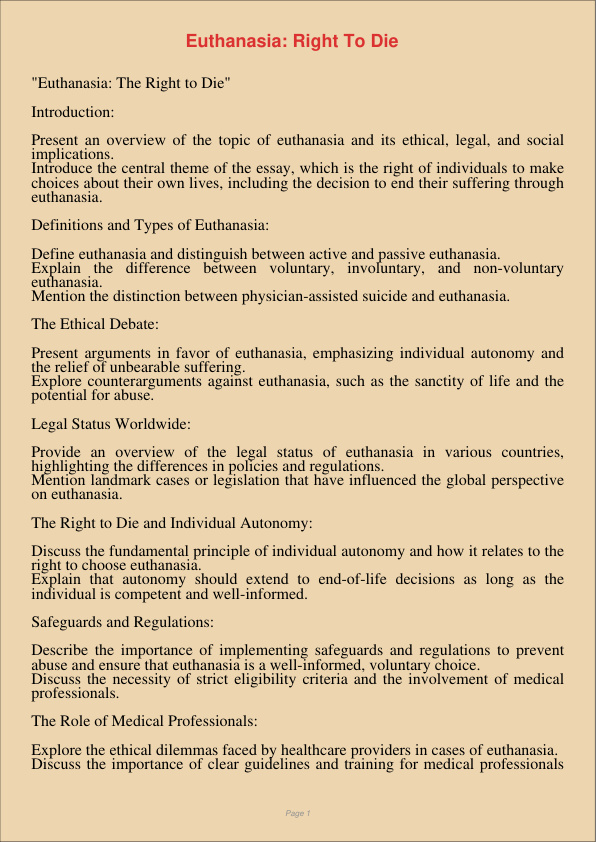Euthanasia Right To Die
Jan 12, 2024
right
euthanasia
Biology
Journalism & Communication

“Euthanasia: The Right to Die”
Introduction:
Present an overview of the topic of euthanasia and its ethical, legal, and social implications. Introduce the central theme of the essay, which is the right of individuals to make choices about their own lives, including the decision to end their suffering through euthanasia.
Definitions and Types of Euthanasia:
Define euthanasia and distinguish between active and passive euthanasia. Explain the difference between voluntary, involuntary, and non-voluntary euthanasia. Mention the distinction between physician-assisted suicide and euthanasia.
The Ethical Debate:
Present arguments in favor of euthanasia, emphasizing individual autonomy and the relief of unbearable suffering. Explore counterarguments against euthanasia, such as the sanctity of life and the potential for abuse.
Legal Status Worldwide:
Provide an overview of the legal status of euthanasia in various countries, highlighting the differences in policies and regulations. Mention landmark cases or legislation that have influenced the global perspective on euthanasia.
The Right to Die and Individual Autonomy:
Discuss the fundamental principle of individual autonomy and how it relates to the right to choose euthanasia. Explain that autonomy should extend to end-of-life decisions as long as the individual is competent and well-informed.
Safeguards and Regulations:
Describe the importance of implementing safeguards and regulations to prevent abuse and ensure that euthanasia is a well-informed, voluntary choice. Discuss the necessity of strict eligibility criteria and the involvement of medical professionals.
The Role of Medical Professionals:
Explore the ethical dilemmas faced by healthcare providers in cases of euthanasia. Discuss the importance of clear guidelines and training for medical professionals to navigate end-of-life decisions.
Religious and Cultural Perspectives:
Examine the varying viewpoints on euthanasia within different religious and cultural contexts. Discuss the influence of religious doctrines and values on public opinion and legislation.
Public Opinion and Surveys:
Present the results of surveys and studies that reflect public opinion on euthanasia. Discuss how changing attitudes may impact the legalization of euthanasia.
Case Studies:
Provide real-life case studies that illustrate the complexity of euthanasia decisions and their impact on individuals and families.
Euthanasia in Special Cases:
Discuss the application of euthanasia in special cases, such as terminally ill patients, those with unbearable suffering, and minors. Debate the ethical and legal challenges in such scenarios.
Conclusion:
Summarize the key arguments for and against euthanasia, emphasizing the right to die and individual autonomy. Highlight the ongoing ethical, legal, and cultural debates surrounding euthanasia. Encourage further discussion and consideration of end-of-life choices, recognizing the importance of balancing individual rights with safeguards to protect vulnerable individuals.
In conclusion, the right to die through euthanasia is a complex and highly debated issue. It revolves around the fundamental principles of individual autonomy and the relief of suffering, while also posing significant ethical and legal challenges. This essay aims to provide a comprehensive overview of the topic, showcasing the multifaceted nature of the euthanasia debate.